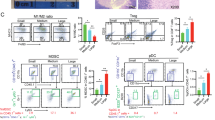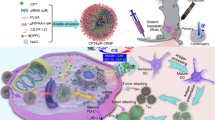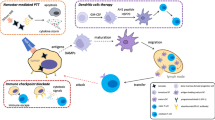Abstract
Radiofrequency ablation (RFA) is the most common approach to thermal ablation for cancer therapy. Unfortunately, its efficacy is limited by incomplete ablation, and further optimization of RFA is required. Here, we demonstrate that incubation at 65 °C triggers more EG7 tumor cell death by necrosis than treatment at 45 °C, and the 65 °C-treated cells are more effective at inducing antigen-specific CD8+ cytotoxic T lymphocyte (CTL) responses after injection in mice than the 45 °C-treated ones. Dendritic cells (DCs) that phagocytose 65 °C-treated EG7 cells become mature with upregulated MHCII and CD80 expression and are capable of efficiently inducing effector CTLs in mouse tumor models. RFA (65 °C) therapy of EG7 tumors induces large areas of tumor necrosis and stimulates CTL responses. This leads to complete regression of small (~100 mm3) tumors but fails to suppress the growth of larger (~350 mm3) tumors. The administration of the Toll-like receptor-9 (TLR9) agonist unmethylated cytosine-phosphorothioate-guanine oligonucleotide (CpG) to DCs phagocytosing 65 °C-treated EG7 cells enhances the expression of MHCII and CD40 on DCs as well as DC-induced stimulation of CTL responses. Importantly, the intratumoral administration of CpG following RFA also increases the frequencies of tumor-associated immunogenic CD11b−CD11c+CD103+ DC2 and CD11b+F4/80+MHCII+ M1 macrophages and increases CD4+ and CD8+ T-cell tumor infiltration, leading to enhanced CD4+ T cell-dependent CTL responses and potent inhibition of primary RFA-treated or distant untreated tumor growth as well as tumor lung metastasis in mice bearing larger tumors. Overall, our data indicate that CpG administration, which enhances RFA-induced CTL responses and ultimately potentiates the inhibition of primary tumor growth and lung metastasis, is a promising strategy for improving RFA treatment, which may assist in optimizing this important cancer therapy.
This is a preview of subscription content, access via your institution
Access options
Subscribe to this journal
Receive 12 digital issues and online access to articles
$119.00 per year
only $9.92 per issue
Buy this article
- Purchase on Springer Link
- Instant access to full article PDF
Prices may be subject to local taxes which are calculated during checkout






Similar content being viewed by others
References
Wust, P. et al. Hyperthermia in combined treatment of cancer. Lancet Oncol. 3, 487–497 (2002).
Lencioni, R. et al. Early-stage hepatocellular carcinoma in patients with cirrhosis: long-term results of percutaneous image-guided radiofrequency ablation. Radiology 234, 961–967 (2005).
Gillams, A. & Lees, W. Five-year survival in 309 patients with colorectal liver metastases treated with radiofrequency ablation. Eur. Radiol. 19, 1206–1213 (2009).
Zemlyak, A., Moore, W. H. & Bilfinger, T. V. Comparison of survival after sublobar resections and ablative therapies for stage I non-small cell lung cancer. J. Am. Coll. Surg. 211, 68–72 (2010).
Chu, K. F. & Dupuy, D. E. Thermal ablation of tumours: biological mechanisms and advances in therapy. Nat. Rev. Cancer 14, 199–208 (2014).
Williams, M. A. & Bevan, M. J. Effector and memory CTL differentiation. Annu Rev. Immunol. 25, 171–192 (2007).
Wissniowski, T. T. et al. Activation of tumor-specific T lymphocytes by radio-frequency ablation of the VX2 hepatoma in rabbits. Cancer Res. 63, 6496–6500 (2003).
Shi, L. et al. PD-1 blockade boosts radiofrequency ablation-elicited adaptive immune responses against tumor. Clin. Cancer Res. 22, 1173–1184 (2016).
Zerbini, A. et al. Radiofrequency thermal ablation of hepatocellular carcinoma liver nodules can activate and enhance tumor-specific T-cell responses. Cancer Res. 66, 1139–1146 (2006).
Napoletano, C. et al. RFA strongly modulates the immune system and anti-tumor immune responses in metastatic liver patients. Int J. Oncol. 32, 481–490 (2008).
Widenmeyer, M. et al. Analysis of tumor antigen-specific T cells and antibodies in cancer patients treated with radiofrequency ablation. Int J. Cancer 128, 2653–2662 (2011).
Sims, S., Willberg, C. & Klenerman, P. MHC-peptide tetramers for the analysis of antigen-specific T cells. Expert Rev. Vaccin. 9, 765–774 (2010).
Albert, M. L., Sauter, B. & Bhardwaj, N. Dendritic cells acquire antigen from apoptotic cells and induce class I-restricted CTLs. Nature 392, 86–89 (1998).
Goldszmid, R. S. et al. Dendritic cells charged with apoptotic tumor cells induce long-lived protective CD4+and CD8+T cell immunity against B16 melanoma. J. Immunol. 171, 5940–5947 (2003).
Inzkirweli, N. et al. Antigen loading of dendritic cells with apoptotic tumor cell-preparations is superior to that using necrotic cells or tumor lysates. Anticancer Res. 27, 2121–2129 (2007).
Chen, Z. et al. Efficient antitumor immunity derived from maturation of dendritic cells that had phagocytosed apoptotic/necrotic tumor cells. Int J. Cancer 93, 539–548 (2001).
Parameswaran, S., Khalil, M., Ahmed, K. A., Sharma, R. K. & Xiang, J. Enhanced protective immunity derived from dendritic cells with phagocytosis of CD40 ligand transgene-engineered apoptotic tumor cells via increased dendritic cell maturation. Tumori 101, 637–643 (2015).
Zhang, B. et al. Study of the relationship between the target tissue necrosis volume and the target tissue size in liver tumours using two-compartment finite element RFA modelling. Int J. Hyperthermia 30, 593–602 (2014).
Zhang, B., Moser, M. A., Luo, Y., Zhang, E. M. & Zhang, W. Evaluation of the current radiofrequency ablation systems using axiomatic design theory. Proc. Inst. Mech. Eng. H 228, 397–408 (2014).
Erez, A. & Shitzer, A. Controlled destruction and temperature distributions in biological tissues subjected to monoactive electrocoagulation. J. Biomech. Eng. 102, 42–49 (1980).
Hemmi, H. et al. A Toll-like receptor recognizes bacterial DNA. Nature 408, 740–745 (2000).
Zhang, X., Munegowda, M. A., Yuan, J., Wei, Y. & Xiang, J. Optimal TLR9 signal converts tolerogenic CD4–8–DCs into immunogenic ones capable of stimulating antitumor immunity via activating CD4+Th1/Th17 and NK cell responses. J. Leukoc. Biol. 88, 393–403 (2010).
Xie, Y. F. et al. A novel T cell-based vaccine capable of stimulating long-term functional CTL memory against B16 melanoma via CD40L signaling. Cell Mol. Immunol. 10, 72–77 (2013).
Zhang, B., Moser, M. A., Zhang, E. M., Luo, Y. & Zhang, W. Numerical analysis of the relationship between the area of target tissue necrosis and the size of target tissue in liver tumours with pulsed radiofrequency ablation. Int J. Hyperthermia 31, 715–725 (2015).
Umeshappa, C. S. et al. Innate and adoptive immune cells contribute to natural resistance to systemic metastasis of B16 melanoma. Cancer Biother Radiopharm. 30, 72–78 (2015).
Xu, A., Zhang, L., Chen, Y., Lin, Z. & Li, R. Immunogenicity and efficacy of a rationally designed vaccine against vascular endothelial growth factor in mouse solid tumor models. Cancer Immunol. Immunother. 66, 181–192 (2017).
Wang, R. et al. Novel exosome-targeted T-cell-based vaccine counteracts T-cell anergy and converts CTL exhaustion in chronic infection via CD40L signaling through the mTORC1 pathway. Cell Mol. Immunol. 14, 529–545 (2017).
Broz, M. L. et al. Dissecting the tumor myeloid compartment reveals rare activating antigen-presenting cells critical for T cell immunity. Cancer Cell 26, 638–652 (2014).
Soncin, I. et al. The tumour microenvironment creates a niche for the self-renewal of tumour-promoting macrophages in colon adenoma. Nat. Commun. 9, 582 (2018).
Liu, Y. & Cao, X. Intratumoral dendritic cells in the anti-tumor immune response. Cell Mol. Immunol. 12, 387–390 (2015).
Itano, A. A. et al. Distinct dendritic cell populations sequentially present antigen to CD4 T cells and stimulate different aspects of cell-mediated immunity. Immunity 19, 47–57 (2003).
Kerr, J. F., Wyllie, A. H. & Currie, A. R. Apoptosis: a basic biological phenomenon with wide-ranging implications in tissue kinetics. Br. J. Cancer 26, 239–257 (1972).
Woo, M., Hakem, R. & Mak, T. W. Executionary pathway for apoptosis: lessons from mutant mice. Cell Res. 10, 267–278 (2000).
Krysko, D. V., D’Herde, K. & Vandenabeele, P. Clearance of apoptotic and necrotic cells and its immunological consequences. Apoptosis 11, 1709–1726 (2006).
Xie, Y. et al. Membrane-bound HSP70-engineered myeloma cell-derived exosomes stimulate more efficient CD8(+) CTL- and NK-mediated antitumour immunity than exosomes released from heat-shocked tumour cells expressing cytoplasmic HSP70. J. Cell Mol. Med. 14, 2655–2666 (2010).
Figueiredo, C. et al. Heat shock protein 70 (HSP70) induces cytotoxicity of T-helper cells. Blood 113, 3008–3016 (2009).
Poon, I. K. H., Hulett, M. D. & Parish, C. R. Molecular mechanisms of late apoptotic/necrotic cell clearance. Cell Death Differ. 17, 381–397 (2010).
Shi, H. et al. Hyperthermia enhances CTL cross-priming. J. Immunol. 176, 2134–2141 (2006).
Yang, D. et al. High mobility group box-1 protein induces the migration and activation of human dendritic cells and acts as an alarmin. J. Leukoc. Biol. 81, 59–66 (2007).
Vorotnikova, E., Ivkov, R., Foreman, A., Tries, M. & Braunhut, S. J. The magnitude and time-dependence of the apoptotic response of normal and malignant cells subjected to ionizing radiation versus hyperthermia. Int J. Radiat. Biol. 82, 549–559 (2006).
Garcia, M. P., Cavalheiro, J. R. & Fernandes, M. H. Acute and long-term effects of hyperthermia in B16-F10 melanoma cells. PLoS ONE 7, e35489 (2012).
Shan, C. C. et al. Cytokine-induced killer cells co-cultured with dendritic cells loaded with the protein lysate produced by radiofrequency ablation induce a specific antitumor response. Oncol. Lett. 9, 1549–1556 (2015).
Silvestrini, M. T. et al. Priming is key to effective incorporation of image-guided thermal ablation into immunotherapy protocols. JCI Insight 2, e90521 (2017).
Domingo-Musibay, E. et al. Endogenous heat-shock protein induction with or without radiofrequency ablation or cryoablation in patients with stage IV melanoma. Oncologist 22, 1026–e1093 (2017).
Chavez, M. et al. Distinct immune signatures in directly treated and distant tumors result from TLR adjuvants and focal ablation. Theranostics 8, 3611–3628 (2018).
Dromi, S. A. et al. Radiofrequency ablation induces antigen-presenting cell infiltration and amplification of weak tumor-induced immunity. Radiology 251, 58–66 (2009).
Pulendran, B. Modulating vaccine responses with dendritic cells and Toll-like receptors. Immunol. Rev. 199, 227–250 (2004).
Frank, M. J. et al. In situ vaccination with a TLR9 agonist and local low-dose radiation induces systemic responses in untreated indolent lymphoma. Cancer Discov. 8, 1258–1269 (2018).
Ribas, A. et al. SD-101 in combination with pembrolizumab in advanced melanoma: results of a phase Ib, multicenter study. Cancer Discov. 8, 1250–1257 (2018).
McDonnell, A. M. et al. Tumor-infiltrating dendritic cells exhibit defective cross-presentation of tumor antigens, but is reversed by chemotherapy. Eur. J. Immunol. 45, 49–59 (2015).
Colombo, M. P. & Mantovani, A. Targeting myelomonocytic cells to revert inflammation-dependent cancer promotion. Cancer Res. 65, 9113–9116 (2005).
Zeisberger, S. M. et al. Clodronate-liposome-mediated depletion of tumour-associated macrophages: a new and highly effective antiangiogenic therapy approach. Br. J. Cancer 95, 272–281 (2006).
Mantovani, A. et al. The chemokine system in diverse forms of macrophage activation and polarization. Trends Immunol. 25, 677–686 (2004).
Murray, P. J. & Wynn, T. A. Protective and pathogenic functions of macrophage subsets. Nat. Rev. Immunol. 11, 723–737 (2011).
Chanmee, T., Ontong, P., Konno, K. & Itano, N. Tumor-associated macrophages as major players in the tumor microenvironment. Cancers 6, 1670–1690 (2014).
Huang, L., Xu, H. & Peng, G. TLR-mediated metabolic reprogramming in the tumor microenvironment: potential novel strategies for cancer immunotherapy. Cell Mol. Immunol. 15, 428–437 (2018).
Ma, C., Spies, N.P., Gong, T., Jones, C.X. & Chu, W.M. Involvement of DNA-PKcs in the type I IFN response to CpG-ODNs in conventional dendritic cells in TLR9-dependent or -independent manners. PLoS One. 10, e0121371 (2015).
Liu, Q. et al. Abrogation of local cancer recurrence after radiofrequency ablation by dendritic cell-based hyperthermic tumor vaccine. Mol. Ther. 17, 2049–2057 (2009).
Reed, S. G., Bertholet, S., Coler, R. N. & Friede, M. New horizons in adjuvants for vaccine development. Trends Immunol. 30, 23–32 (2009).
Amos, S. M. et al. Adoptive immunotherapy combined with intratumoral TLR agonist delivery eradicates established melanoma in mice. Cancer Immunol. Immunother. 60, 671–683 (2011).
Molenkamp, B. G. et al. Local administration of PF-3512676 CpG-B instigates tumor-specific CD8+T-cell reactivity in melanoma patients. Clin. Cancer Res. 14, 4532–4542 (2008).
Dewan, M. Z. et al. Synergy of topical toll-like receptor 7 agonist with radiation and low-dose cyclophosphamide in a mouse model of cutaneous breast cancer. Clin. Cancer Res. 18, 6668–6678 (2012).
Adams, S. et al. Topical TLR7 agonist imiquimod can induce immune-mediated rejection of skin metastases in patients with breast cancer. Clin. Cancer Res 18, 6748–6757 (2012).
Acknowledgements
This work was supported by grants from CoMRAD (#417578), College of Medicine, University of Saskatchewan, Prostate Cancer Fight Foundation (#417782), Royal University Hospital Research Foundation (#417450) and Saskatchewan Health Research Foundation (#418672).
Author information
Authors and Affiliations
Corresponding author
Ethics declarations
Competing interests
The authors declare no competing interests.
Additional information
Publisher’s note: Springer Nature remains neutral with regard to jurisdictional claims in published maps and institutional affiliations.
Rights and permissions
About this article
Cite this article
Xu, A., Zhang, L., Yuan, J. et al. TLR9 agonist enhances radiofrequency ablation-induced CTL responses, leading to the potent inhibition of primary tumor growth and lung metastasis . Cell Mol Immunol 16, 820–832 (2019). https://doi.org/10.1038/s41423-018-0184-y
Received:
Accepted:
Published:
Issue Date:
DOI: https://doi.org/10.1038/s41423-018-0184-y
Keywords
This article is cited by
-
Nanomedicine-based adjuvant therapy: a promising solution for lung cancer
Journal of Nanobiotechnology (2023)
-
Microwave ablation of primary breast cancer inhibits metastatic progression in model mice via activation of natural killer cells
Cellular & Molecular Immunology (2021)
-
Distinct roles but cooperative effect of TLR3/9 agonists and PD-1 blockade in converting the immunotolerant microenvironment of irreversible electroporation-ablated tumors
Cellular & Molecular Immunology (2021)



